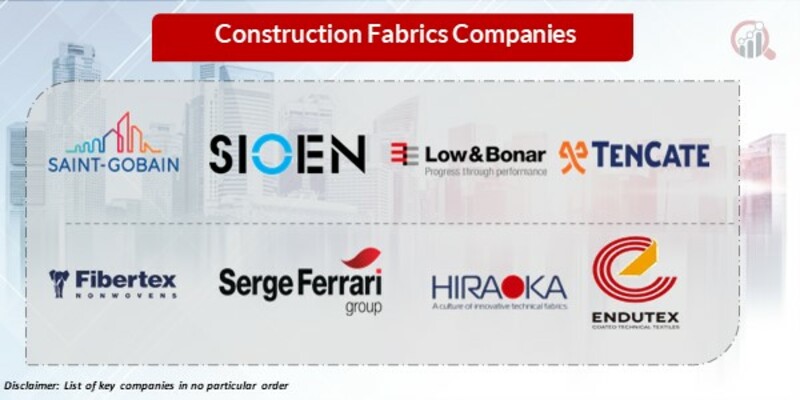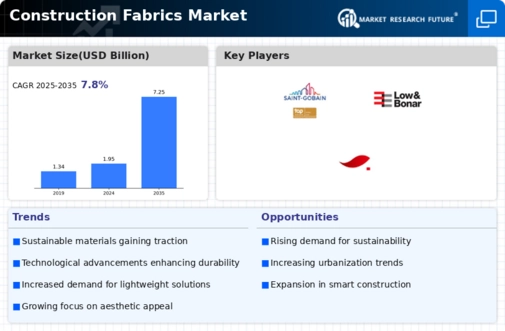Top Industry Leaders in the Construction Fabrics Market

The construction fabrics market, a canvas woven from technical textiles and architectural vision, is experiencing a vibrant boom. Its diverse range of applications, from tensile structures and awnings to roofing and façade systems, is fueling a dynamic competitive landscape. As players maneuver to secure a foothold, let's delve into this intricate tapestry, exploring the factors shaping market share, the strategies adopted by key players, industry news, and the recent developments that are reshaping the future.
Market Share: A Multi-Layered Tapestry
Several threads intertwine to determine market share in this intricate fabric:
-
Product Type: The market spans diverse segments like tensile fabrics, geotextiles, filtration fabrics, and waterproof membranes. Each segment caters to specific needs, with tensile fabrics dominating the architectural market and geotextiles leading in infrastructure projects. -
Material Composition: While polyester reigns supreme due to its affordability and versatility, PTFE, PVC, and other high-performance materials are gaining traction for their superior strength, durability, and weather resistance. -
Application Scope: The market caters to a wide spectrum, from residential and commercial buildings to sports facilities, transportation infrastructure, and environmental projects. The specific application influences fabric choice and market dynamics. -
Geographical Distribution: The market is primarily driven by North America and Europe, but Asia Pacific is witnessing rapid growth, fueled by urbanization and infrastructure development. Regional preferences and regulations play a significant role. -
Player Strategies: Established giants and innovative startups vie for attention, employing diverse strategies like product diversification, technological advancements, sustainability initiatives, and strategic partnerships.
Strategies: Stitching Together Success
Players in the construction fabrics market are weaving unique strategies to secure their share of the market:
-
Product Innovation: Developing fabrics with enhanced properties like self-cleaning, fire-retardant, and energy-efficient capabilities caters to evolving demands and differentiates players from the competition. -
Sustainability Focus: Highlighting the eco-friendly aspects of construction fabrics, such as their recyclability and durability, resonates with environmentally conscious consumers and aligns with green building regulations. -
Technological Advancements: Implementing advanced weaving and coating technologies, as well as exploring new materials like bio-based fibers, paves the way for lighter, stronger, and more sustainable fabrics. -
Market Expansion: Entering new geographical markets or expanding existing footprints in high-growth regions like Asia Pacific and Africa fuels market share growth. -
Strategic Partnerships: Collaborating with architects, engineers, and construction companies opens up new avenues for product development and market reach.
Key Players:
Saint-Gobain (France), Sioen Industries NV (Belgium), Low & Bonar (UK), Sattler AG (Austria), Koninklijke Ten Cate bv (the Netherlands), Fibertex Nonwovens A/S (Denmark), Serge Ferrari (France), HIRAOKA & CO. LTD. (Japan), Endutex Coated Technical Textiles (Portugal), Seaman Corporation (US), and Stylepark AG (Germany).
Recent Developments:
July 2023: The International Geosynthetics Society releases a new report highlighting the growing importance of geotextiles in sustainable infrastructure development.
August 2023: Saint-Gobain, a leading construction fabrics manufacturer, announces plans to invest in a new production facility in China to cater to the growing Asian market.
September 2023: The National Roofing Contractors Association reports a 10% increase in the use of waterproof membranes in commercial roofing projects.
October 2023: Serge Ferrari, a renowned French fabric manufacturer, unveils a new line of translucent fabrics with superior energy-saving properties.
November 2023: The American Society of Landscape Architects recognizes a project that utilizes innovative bio-based fabrics for sustainable landscaping practices.
December 2023: A consortium of leading research institutions announces a breakthrough in the development of self-healing fabrics for construction applications, potentially improving durability and reducing maintenance costs.









